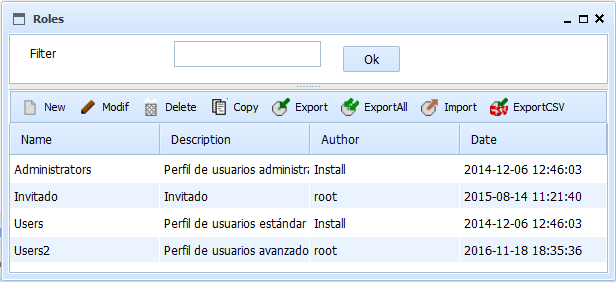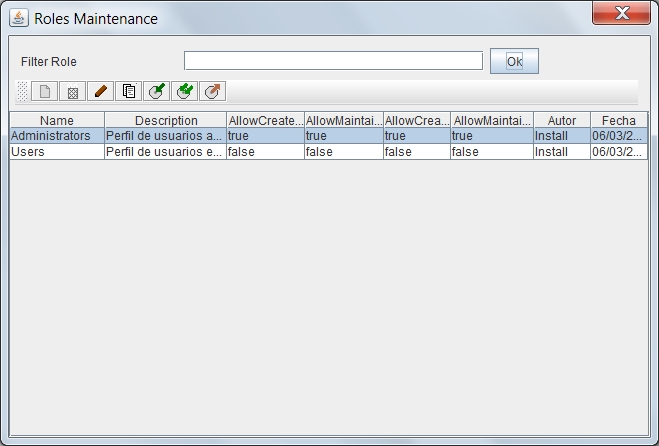
By selecting the option to manage Roles, will appear the form "list of Roles". This form allows you to maintain all the system Roles.
The role allows you to set permissions for a user to perform activities on types of items. Permits are complementary and additional to the ACL. Users are assigned a role, indicating what kind of operations can be performed. Although authorized to perform these operations, access to each particular item depends on the object's ACL. That is, if a user can not modify groups, you can not even try to modify one. If you have permission to change groups, you can change one and not others depending on the specific ACL in each group. This allows to distribute the work delegating different tasks in different people according to their profiles. Thus, a user with knowledge of document management can keep the definitions of the types of documents and other user may be responsible for maintaining the security of users and groups (or even a single group) to avoid collisions. A user query may have limited all permits to ensure that errors in the definition of ACL does not grant permission unexpected
The permits included in each role are:
To filter the Role or list of Roles you want to review, just enter part of the name in the text box and press "ok". The list of Roles that meet the conditions will be shown on the results table. Pressing the button without entering any value you see all the elements on which the user has permission. The results table shows the data:

This results table can be sorted by selecting the header of each column. You can also change the size of each column by dragging the separator line in the headers.

Above the table of results there are several buttons for performing operations on the selected item. The available operations are:
 Add a new element
Add a new element Delete the selected element (if it is not used in some document or folder)
Delete the selected element (if it is not used in some document or folder) Modify the selected element
Modify the selected element Create a new item as a copy of the selected item
Create a new item as a copy of the selected item Export the selected item
Export the selected item Export all items listed
Export all items listed Import from file one or more previously saved items
Import from file one or more previously saved items Export all items listed in CSV format so it can be imported in Databases or Spreadsheet
Export all items listed in CSV format so it can be imported in Databases or SpreadsheetIt should be noted on export and import, that some elements may have dependency on others, so you must export all related and imported at the time of it in the proper order.
In the event of an error (lack of user permissions, data inconsistency, etc.), the operation is canceled and will present the reason for the error to the user.
View Roles Maintenance and Users List